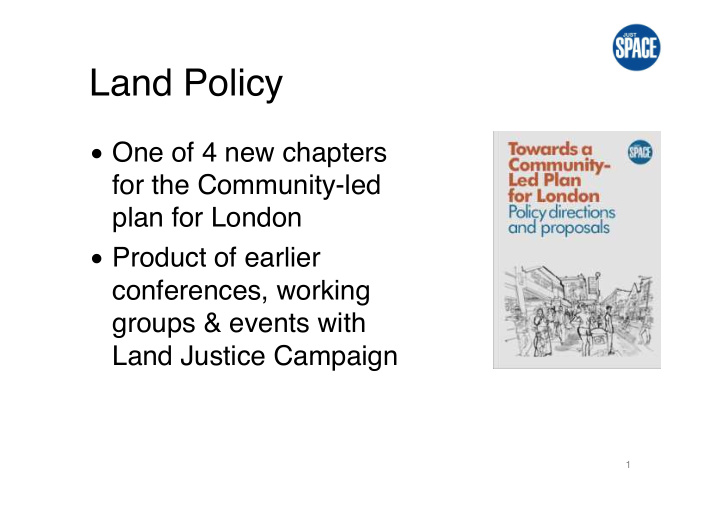



Land Policy • One of 4 new chapters for the Community-led plan for London • Product of earlier conferences, working groups & events with Land Justice Campaign 1
Problems: • City cursed by rent & land • Expression and generator of inequality • Land market pressures drive plans, displace low- and middle-income homes, workplaces • Housing payments impoverish people & prevent other spending • Existing taxes regressive, fail to capture property wealth/income or to supply services & infrastructure 2 2
Yesterday’s FT: scale of house “value” 3
Yesterday’s FT: growth of house “value” Less than 20% of growth is more housing; most is price increase 4
London needs a system which… • Extends the public / collective ownership of land • Taxes captures income and wealth from land fairly • Develops participatory budgets • Diverts investment to productive uses • Redistributes between regions, boroughs, wards 5
Taxation: LVT? • Captures value growth from • LVT encourages intensification the whole of the stock, not just of use and thus threatens a new development variety of lower density and non-profit uses. • Everyone benefits from the • Is an approach which makes underlying value of land and all uplifts, rather than just the the market work better, more owners of land ‘efficiently’, and not an approach whose first principle • By taxing land that is currently is to take more land use kept idle, LVT encourages decisions out of the market, better use of land priorities being set through • Discourages under-use of land political debate and participatory planning. • To be feasible, would need to specify precisely the permitted use and maximum density for • But… every plot of land 6
How? • Legislation needed, but… • London should lead on – Research & education – National/international discussions • Mayor lobbying governments… – Viability – Disposal of public land (NHS etc) – Existing Use Value in CPOs – Local government finance review 7
First steps – Mayor should lower land price expectations by • Enforcing upper density limits without flexibility • Enforcing his 35% “affordability” threshold without flexibility • Specifying the date at which 35%”affordability” will become 50% • Making his definitions of “affordable” housing much more affordable, relating them to local incomes, not local market rents • Applying his requirement of no net loss of social housing equally across all renewal schemes over which he has any planning or financial leverage – Require that TfL and other Mayoral-family lands that are disposed of for housing development are used substantially for social housing or other social purposes 8
The full draft chapter is at JustSpace.org.uk • The land is where we all live, build, grow food, do things together in a great diversity of organised and spontaneous ways. • The private ownership of land rights has evolved over a long period. It enables owners to secure —as rents and as capital gains— a huge and growing share of the social product, concentrating wealth and lowering the standard of living for many people in the society. • London as a huge and dominant city creates especially strong profit opportunities alongside unique impoverishment. As land value has mushroomed, there is lots of money being made; more of it could go on what we need and less be distributed as profits and capital gains. 9
Recommend
More recommend